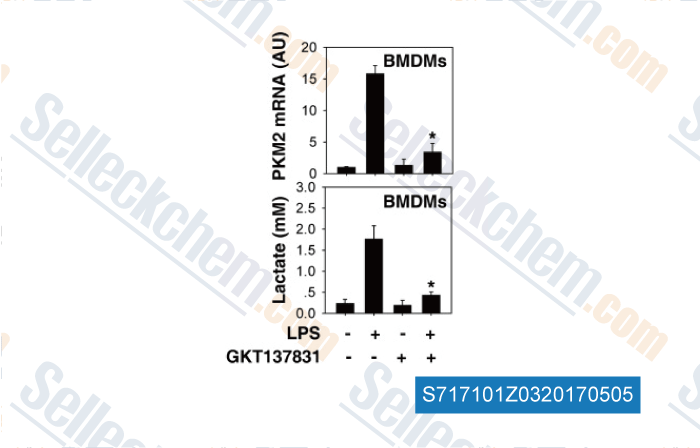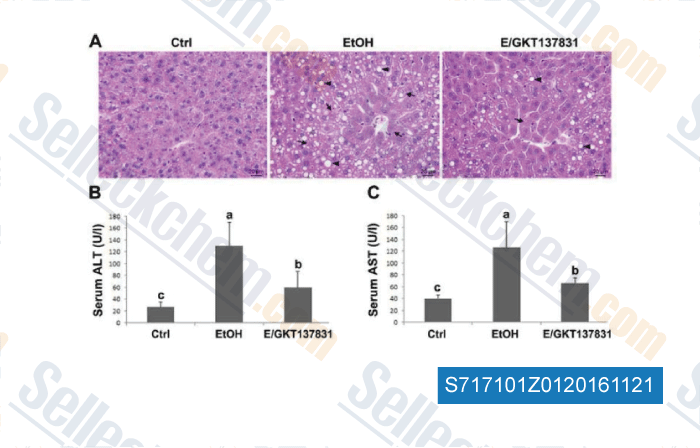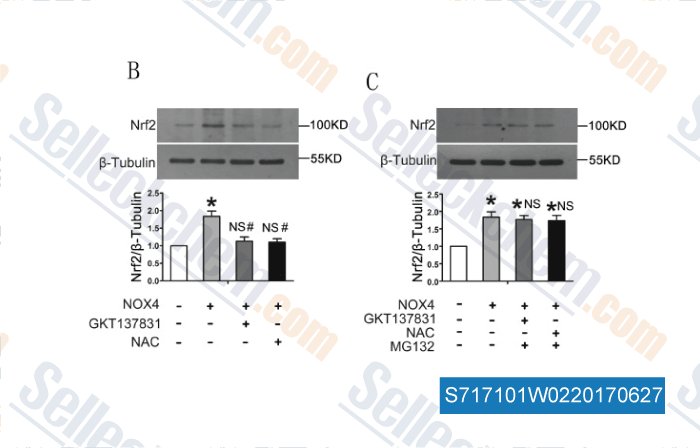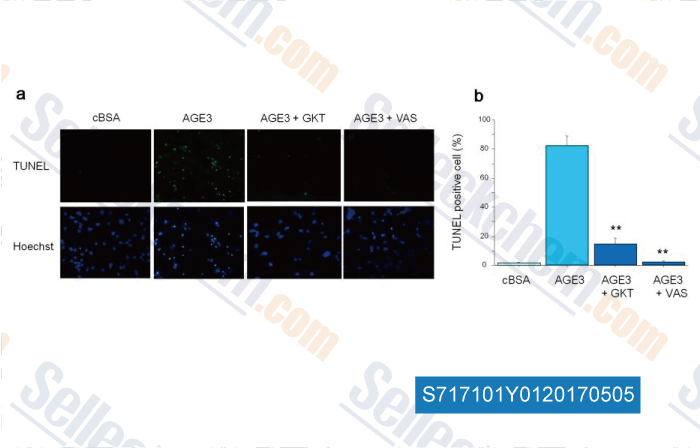|
Toll Free: (877) 796-6397 -- USA and Canada only -- |
Fax: +1-832-582-8590 Orders: +1-832-582-8158 |
Tech Support: +1-832-582-8158 Ext:3 Please provide your Order Number in the email. |
Technical Data
| Formula | C21H19ClN4O2 |
|||
| Molecular Weight | 394.85 | CAS No. | 1218942-37-0 | |
| Solubility (25°C)* | In vitro | DMSO | 78 mg/mL (197.54 mM) | |
| Water | Insoluble | |||
| Ethanol | Insoluble | |||
|
* <1 mg/ml means slightly soluble or insoluble. * Please note that Selleck tests the solubility of all compounds in-house, and the actual solubility may differ slightly from published values. This is normal and is due to slight batch-to-batch variations. * Room temperature shipping (Stability testing shows this product can be shipped without any cooling measures.) |
||||
Preparing Stock Solutions
Biological Activity
| Description | Setanaxib (GKT137831, GKT831) is a potent, dual NADPH oxidase NOX1/NOX4 inhibitor with Ki of 110 nM and 140 nM, respectively. Treatment with GKT137831 suppresses reactive oxygen species (ROS) production. GKT137831 partly inhibits ferroptosis. | ||||||
|---|---|---|---|---|---|---|---|
| Targets |
|
||||||
| In vitro | GKT137831 attenuates hypoxia-induced H(2)O(2) release, cell proliferation, and TGF-β1 expression and blunted reductions in PPARγ in HPAECs and HPASMCs. [2] GKT137831 also prevents oxidative stress in response to hyperglycemia in human aortic endothelial cells. [3] |
||||||
| In vivo | In WT and SOD1mut mice, GKT137831 (60 mg/kg i.g.) blocks liver fibrosis and downregulates markers of oxidative stress, inflammation, and fibrosis. [1] GKT137831 (60 mg/kg/d p.o.) also attenuates chronic hypoxia–induced right ventricular hypertrophy, vascular remodeling, lung cell proliferation, and hypoxic alterations in lung PPARγ and TGF-β1 expression in mouse model of chronic hypoxia exposure. [2] In diabetic apolipoprotein E-deficient mice, GKT137831 (60 mg/kg/d p.o.) attenuates diabetes mellitus-accelerated atherosclerosis. [3] Moreover, in angII-infused c-hNox4Tg mice, GKT137831 abolishes the increase in oxidative stress, suppresses Akt-mTOR and NF-κB signaling pathway and attenuates cardiac remodeling. [4] |
Protocol (from reference)
| Cell Assay: |
|
|---|---|
| Animal Study: |
|
References
Customer Product Validation

-
, , Mol Med, 2016, doi: 10.2119/molmed.2015.00250

-
Data from [Data independently produced by , , Biochim Biophys Acta, 2016, 1861(1 Pt A):2912-2921. ]

-
Data from [Data independently produced by , , Exp Cell Res, 2017, 352(2):245-254]

-
Data from [Data independently produced by , , Int J Mol Sci, 2016, 17(9). pii: E1567]
Selleck's Setanaxib (GKT137831) has been cited by 76 publications
| A bladder-blood immune barrier constituted by suburothelial perivascular macrophages restrains uropathogen dissemination [ Immunity, 2025, S1074-7613(25)00069-X] | PubMed: 40015270 |
| Remote Ischemic Preconditioning Attenuates Mitochondrial Dysfunction and Ferroptosis of Tubular Epithelial Cells by Inhibiting NOX4-ROS Signaling in Acute Kidney Injury [ Int J Biol Sci, 2025, 21(5):2313-2329] | PubMed: 40083709 |
| trans-Endothelial neutrophil migration activates bactericidal function via Piezo1 mechanosensing [ Immunity, 2024, 57(1):52-67.e10] | PubMed: 38091995 |
| Inhibition of neutrophil swarming by type I interferon promotes intracellular bacterial evasion [ Nat Commun, 2024, 15(1):8663] | PubMed: 39375351 |
| Autophagy-mediated activation of the AIM2 inflammasome enhances M1 polarization of microglia and exacerbates retinal neovascularization [ MedComm (2020), 2024, 5(8):e668] | PubMed: 39081514 |
| Autophagy caused by oxidative stress promotes TGF-β1-induced epithelial-to-mesenchymal transition in human peritoneal mesothelial cells [ Cell Death Dis, 2024, 15(5):365] | PubMed: 38806451 |
| Setanaxib mitigates oxidative damage following retinal ischemia-reperfusion via NOX1 and NOX4 inhibition in retinal ganglion cells [ Biomed Pharmacother, 2024, 170:116042] | PubMed: 38118351 |
| LRRC8A drives NADPH oxidase-mediated mitochondrial dysfunction and inflammation in allergic rhinitis [ J Transl Med, 2024, 22(1):1034] | PubMed: 39550567 |
| Sevoflurane Exposure Induces Neuronal Cell Ferroptosis Initiated by Increase of Intracellular Hydrogen Peroxide in the Developing Brain via ER Stress ATF3 Activation [ Mol Neurobiol, 2024, 61(4):2313-2335] | PubMed: 37874483 |
| Fibroblast growth factor 18 alleviates stress-induced pathological cardiac hypertrophy in male mice [ Nat Commun, 2023, 14(1):1235] | PubMed: 36871047 |
RETURN POLICY
Selleck Chemical’s Unconditional Return Policy ensures a smooth online shopping experience for our customers. If you are in any way unsatisfied with your purchase, you may return any item(s) within 7 days of receiving it. In the event of product quality issues, either protocol related or product related problems, you may return any item(s) within 365 days from the original purchase date. Please follow the instructions below when returning products.
SHIPPING AND STORAGE
Selleck products are transported at room temperature. If you receive the product at room temperature, please rest assured, the Selleck Quality Inspection Department has conducted experiments to verify that the normal temperature placement of one month will not affect the biological activity of powder products. After collecting, please store the product according to the requirements described in the datasheet. Most Selleck products are stable under the recommended conditions.
NOT FOR HUMAN, VETERINARY DIAGNOSTIC OR THERAPEUTIC USE.
